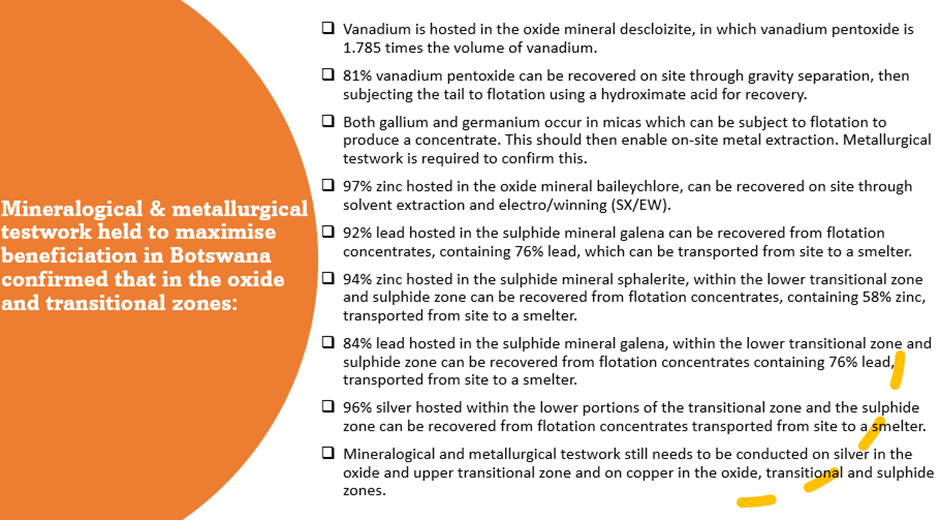Highlights
- Mount Burgess Mining has centred its focus on developing its Kihabe and Nxuu deposits in Botswana.
- The ASX-listed firm has decided to continue to focus on developing the totally oxidised Nxuu Deposit first, following the in-house assessment.
- There have been significant increases in the prices of minerals including vanadium pentoxide, gallium, and germanium.
- MTB has applied for an extension of PL 43/2016, considering the potential for further discoveries of minerals.
With the successful discovery of the Red October Gold Deposit in Western Australia and the three kimberlites in Namibia, Mount Burgess Mining NL (ASX:MTB) has embarked on a journey to make its mark in the mining industry. Currently, the ASX-listed firm is engaged in developing the Kihabe and Nxuu Zinc/Lead/Silver/Germanium and Vanadium deposits in Botswana.
In this article, we will bring to light the significant developments that have taken place related to the key project in recent times. Also, we have put in detail the key conclusions from related testworks conducted so far. Have a read!
Recent developments at the Kihabe and Nxuu project
There has been advancement in the Kihabe-Nxuu Project after Prospecting Licence PL43/2016 grant.
Mount Burgess has filed an application to the Department of Mines for extending PL 43/2016, an area covering 1,000 sq km, as there is potential for further discoveries of minerals, like vanadium pentoxide, gallium, and germanium. These minerals are believed to occur outside the known silver, lead, and zinc domains. Gallium, in particular, has shown to be present as major isolated intersections.
Also, a sharp hike was recorded in the prices of vanadium pentoxide, gallium and germanium during the COVID-19 pandemic. This drew in potential additional credits for the project.
Now, Mount Burgess plans to conduct additional metallurgical testworks for validating the present process flowsheet. During the testwork, the company will keep its focus on taking absolute advantage of grade and recovery of every mineral of the project that can bring in maximum revenue from beneficiation within Botswana.

Image Source: Company Announcement
All about Nxuu and Kihabe deposits
- The Nxuu Deposit is a low-risk, shallow basin-shaped deposit having a maximum depth of 64m to the base of mineralisation. The average depth to the base of mineralisation of 51 holes drilled and assayed to date is only 41m. Mineralisation occurs in the oxidised Quartz Wacke, which is located within a barren Dolostone basin. The on-site extraction as well as beneficiation of metals can be more easily achieved here as it is a totally oxidised deposit.
Mineralogical and metallurgical testworks have been held at the site to maximise beneficiation within Botswana. The conclusions marked that 93% lead, hosted in cerussite, and 93% zinc, hosted in smithsonite, can be recovered on site by the process of acid leaching.
Also, vanadium is hosted in the oxide mineral descloizite, in which vanadium pentoxide is 1.785 times the volume of vanadium. 81% vanadium pentoxide can be recovered on site through gravity separation. Following which, the tail can be subject to flotation using a hydroximate acid for recovery.
Both gallium and germanium occur in micas, which can be subject to flotation for producing a concentrate. On-site metal extraction can be carried out after this. However, this can be confirmed only with required metallurgical testwork.
- The Kihabe Deposit consists of an upper oxide zone, a transitional zone and a lower sulphide zone. Alongside the development of the Nxuu Deposit, assessment of the oxide zone of the oxide/sulphide Kihabe Deposit was also done, to measure the content of vanadium pentoxide, gallium and germanium. According to the assay results from seven holes drilled in Nov/Dec 2017, there are major intersections of germanium, vanadium, and gallium in the oxide and transitional zones.

Image Source: ©2022 Kalkine Media®, Data Source: Company Announcement
MTB shares traded at AU$0.005 on the ASX on 23 September 2022.



